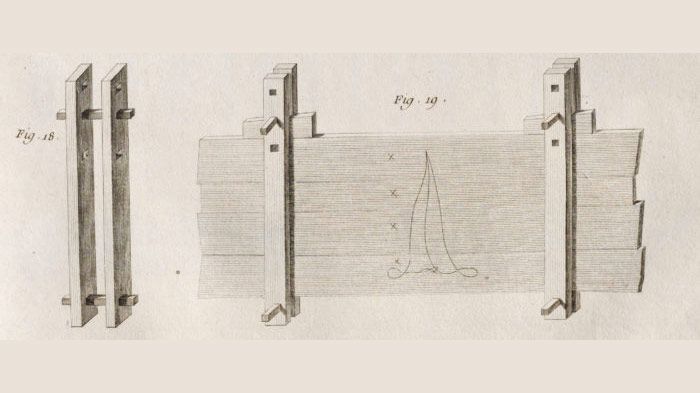‘You WILL obey the triangle’
Unique marking systems are fine – if you're working alone. But in a class setting, Megan Fitzpatrick makes everyone use the marriage marks, for good reason.
I’ve mentioned marriage marks within another post, but I’m reminded of their importance in every class I teach, and I’m struck anew each time by how confusing my “you must use marriage marks” edict can be to those who’ve never before encountered this simple and age-old system. So in each class, I draw out a marriage mark on the chalkboard or whiteboard and explain it (or if those aren’t available, I use the stock itself to demonstrate).
And yet.
In every class, students persist in marking corners with letters or numbers, and writing “front” and “back” on pieces. In one class, I even had a student draw matching pictures on corners. Christopher Schwarz often tells the story of the “compass rose”: A student in a bench class of his didn’t use the triangle; instead he drew a compass rose across his pieces. And when it came time for assembly and things weren’t going together correctly, the student had to scramble to figure out true north. Now, checking everyone’s marriage marks is one of the things both of us do in every class.
Unique marking systems are fine (I guess) if you’re working alone. But in a class, you’re never working alone. So I still make everyone mark the triangle, because at the end of the day, when the glue bottle is open and the clamps are at the ready, it’s the triangle that I insist we look at. That way, we’re all using the same system, and when multiple people are helping with every glue-up in a large project, that’s key. The joke around here is that the collective IQ in the room drops with every glue bottle open, so the less confusion the better.

And it’s just so simple. Arrange the pieces as they will go together, then mark a triangle across the top of your workpieces with the point facing the front. Match up the triangles, et voila. It works on case pieces (the marks are on the top edges), table legs (the marks are on the top of the legs), panel glue-ups (the mark is a big triangle across the top face that spans all the pieces), and more. And I always leave the marks in place until after glue-up, unless it truly isn’t possible, in which case I replicate them on blue tape and stick ’em in place.


And because I studied Shakespeare in my non-woodworking life, I couldn’t help but turn to his Sonnet 116 (“Let me not to the marriage of true minds admit impediments…”) as inspiration for a woodworking poem:
Let me not to the marriage of two boards
Admit impediments. Marks are not marks
Which alter when the marker ignores
Or tries with the eraser to remove.
O no! They are ever-fixed marks
That look on singular systems and scoff;
They are the guide to all board arrangement,
To all dovetail transfer and assembly.
Marriage marks are not time’s fool, though new ideas
Within the mind of makers may come;
Marks alter not in any woodworking project,
But save the maker from assemblies of doom.
If this be error upon me prov’d
I never mark’d, nor no wood ever glu’d.
What can I say … we have to keep ourselves amused right now, eh?
Fine Woodworking Recommended Products

Bessey K-Body Parallel-Jaw Clamp

Bessey EKH Trigger Clamps

Festool DF 500 Q-Set Domino Joiner






















Comments
My current project that has 11 pieces that need to be joined together. Wet glue is no time to be figuring which piece goes where. I have used the triangle marking system for years and I can pick up any piece and know precisely where it goes and which way it faces. Δ
In the edges of a chest or box, I strike them with a chisel. That way they don't disappear. The students often hate it, they want to use a pencil. I then publicly berate them by calling them weak & pathetic, and it helps.
Follansbee
I don't think I can get away with that, Peter...much as I'd often like to!
Log in or create an account to post a comment.
Sign up Log in